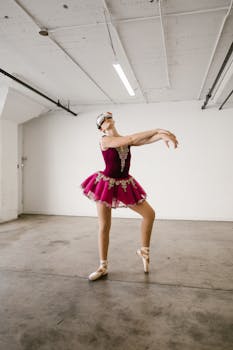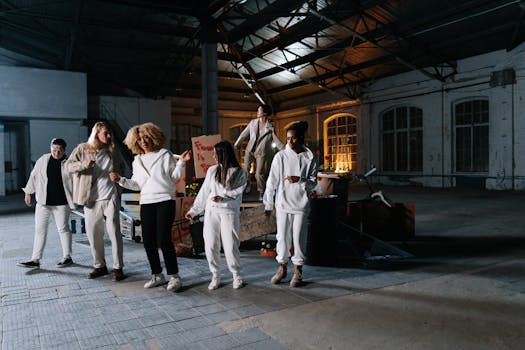Anúncios
Creating engaging dance materials is essential for any instructor, studio owner, or choreographer. The right materials not only enhance the learning experience but also foster a love for dance among students. By following a structured approach, you can develop resources that cater to the specific needs of your dancers.
From lesson plans to performance guides, well-crafted materials can elevate the overall quality of your dance program. Moreover, well-prepared resources ensure that students remain excited and motivated in their dance journey. This article will walk you through the process of creating effective dance materials tailored for your audience.
This guide covers various aspects of dance material creation, including lesson plans, choreography notes, and visual aids. With a focus on clarity and accessibility, you can help dancers of all levels engage more deeply in their practice. Let’s dive into the key steps to develop these essential tools.
Understanding Your Audience
The first step in creating effective dance materials is understanding the needs of your audience. Different groups will require different types of materials. For example, children might need simpler language, while advanced dancers can handle more technical terms.
Conducting surveys or informal interviews can provide valuable insights into their preferences. You should consider factors like age, experience level, and learning styles when developing your materials. This understanding ensures that your resources resonate with the dancers.
Anúncios
Additionally, consider the goals of your audience. Are they aiming to compete, perform, or just dance for fun? Tailoring your materials to meet these objectives enhances their effectiveness. Aligning your content with your audience’s aspirations fosters deeper engagement.
Furthermore, leveraging feedback from previous classes can help refine your approach to material development. Actively seek ways to improve your content based on your dancers’ experiences. Your adaptability will encourage a lively dance community.
Lastly, don’t hesitate to collaborate with fellow instructors or industry professionals. Sharing ideas can lead to innovative approaches that enrich your materials, making them more valuable for your dancers. With a far-reaching perspective, your resources can inspire a broader audience.
Anúncios
Creating Lesson Plans
Lesson plans serve as the backbone of any dance instruction. They outline objectives and structure classes, ensuring a coherent flow. Begin by identifying the goals for each class, whether it’s mastering a specific technique or preparing for a performance.
Once you’ve defined the objectives, break down the class into segments. Each segment should include warm-ups, core activities, and cooldowns. This structured approach helps maintain focus and keeps students engaged throughout the lesson.
Include clear instructions and descriptions for each activity within your lesson plans. Use straightforward language with actionable steps. This clarity helps both experienced instructors and newcomers effectively deliver the material.
Furthermore, remember to cater to varying skill levels within your classes. Offer modifications or challenges based on individual dancer needs. Such inclusivity promotes a positive learning environment and encourages all students to thrive.
Finally, routinely assess and revise your lesson plans based on class feedback. Adaptability is key—what works one term may not work the next. Continuous improvement will keep your lessons relevant and effective.
Developing Choreography Notes
Choreography notes play a crucial role in documenting movement sequences. Detail every step, including counts, transitions, and formations within your notes. A thorough documentation ensures dancers can understand and perform the choreography accurately.
To enhance clarity, use visuals alongside your written notes. Diagrams can help dancers visualize spatial dynamics, making it easier to remember formations. Accompanying descriptions with visuals offers a multi-dimensional learning experience.
Additionally, highlight critical moments in your choreography notes. Identify key expressions, energy levels, or dynamics that should be emphasized. These insights enable dancers to connect emotionally with the performance.
Consider categorizing your choreography notes based on various themes or styles. This organization makes it easier for you and your dancers to revisit specific pieces for reference or practice. An organized library of choreography will be a valuable asset.
Lastly, share your choreography notes with your dancers for personal practice. Empowering them with resources allows for independent exploration and improvement, enhancing their overall dance skills.
Creating Visual Aids
Visual aids can significantly enhance the learning process for dancers. These materials can include diagrams, videos, or infographics that illustrate movement concepts. They make abstract ideas more tangible and easier to grasp.
For diagrams, consider illustrating basic positions or alignment stances relevant to your curriculum. Use colors and labels effectively to highlight important aspects. The clearer the visuals, the easier it will be for dancers to incorporate them into their practice.
Videos can serve as excellent visual aids as well. Record yourself demonstrating techniques or choreography, allowing dancers to see the nuances involved in executing the moves correctly. Video feedback provides critical insight into self-improvement.
Infographics can summarize key concepts, like anatomy, musicality, or styles of dance, in a visually appealing way. Condensing complex information into bite-sized graphics enhances retention and encourages curiosity about further study.
Finally, distribute these visual aids through your website or social media platforms. Regularly updating your resources keeps your content fresh and engaging, inviting a broader audience to interact with your dance program.
Incorporating Technology
Integrating technology into your dance materials can revolutionize how you engage with your dancers. Apps and online platforms can facilitate communication, provide resources, and even host virtual classes. This adaptability allows for a diverse learning environment.
For lesson-sharing purposes, consider using cloud-based services. These platforms allow you to share lesson plans, choreography notes, and visual aids, making access easy for students. Keeping materials organized online increases efficiency for both instructors and dancers.
Additionally, encouraging the use of educational apps can aid in students’ development outside class time. Many apps offer tutorials, exercises, or even dance challenges that enhance learning. Students will appreciate the opportunity to explore at their own pace.
Utilize online streaming services to host virtual classes or workshops. This flexibility allows you to reach students who may not be able to attend in person. Increased accessibility broadens your impact and engagement.
Lastly, foster online community discussions or forums where dancers can share experiences, ask questions, and support one another. Building such a community around your dance materials will enhance camaraderie among your dancers.
Evaluating and Revising Materials
Continual evaluation of your dance materials is essential for growth. Regularly seek feedback from dancers on what resources they find most useful. Your ongoing engagement with their needs ensures relevance and effectiveness.
Establish a process for gathering input. Consider informal surveys or discussions following classes. This valuable feedback can guide adjustments, helping you refine your materials based on student experiences.
Furthermore, assess the effectiveness of your materials through student progress. Monitor if understanding improves and whether dancers express enthusiasm for the resources provided. Direct correlations will help you determine what’s working and what’s not.
Encourage peer reviews among instructors as well. Collaborating with colleagues can bring fresh perspectives that enhance resource quality. Engaging in this feedback loop fosters a culture of continuous improvement.
Finally, stay updated on trends in dance education. Resources may need to evolve in response to changes in teaching methodologies or styles. Remaining adaptable and open to innovations helps ensure your materials stay current and effective.
Conclusion
Creating effective dance materials is an evolving journey that requires thoughtful consideration and ongoing improvement. By understanding your audience, developing clear lesson plans, and embracing technology, you can create valuable resources that enrich your dance programs.
From visual aids to choreography notes, every aspect plays a significant role in enhancing the learning experience for dancers. By routinely evaluating and revising materials, you can ensure they remain relevant and impactful.
Ultimately, your commitment to providing quality resources nurtures a thriving dance community that fosters creativity, skill development, and a love for the art. Embrace this process, and watch your dancers flourish.



